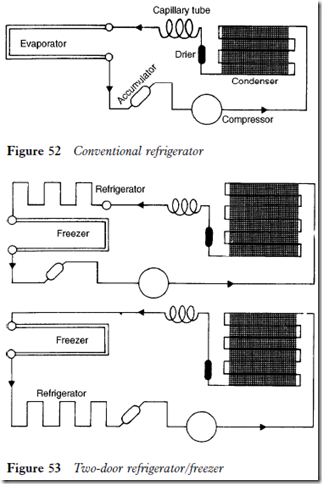Because of the numerous designs of these appliances, a description of the system pipework layout is helpful to the service engineer.
In comparison with commercial or industrial installations, domestic systems are more prone to motor failure and subsequent contamination because few users appreciate the need for adequate air circulation. The method of charging these systems is different because of the minute operating refrigerant charge involved, and the decontamination and evacuation procedure also differs to some extent.
In modern production methods, domestic appliances are assembled and insulated in situ, with an expanded foam insulant. The foam insulant sets and bonds itself to the components it is intended to insulate. The welding technique of fusing aluminium to components and system tubing is often the source of refrigerant leakage. To gain access to the leak area is uneconomical and sometimes not possible without damaging the appliance structure. Overall, therefore, servicing may be somewhat limited.
Many service and repair outlets will not undertake repairs to an evaporator which has developed a leak. A large amount of moisture could have been drawn into the system after the leak had developed by the continuous running of the compressor. This will contaminate the compressor motor, which could fail after a comparatively short operating period following the repair or replacement of the evaporator.
Whenever a system has been subject to moisture contamination it must be thoroughly evacuated. It is often advisable to do this under workshop condi- tions rather than on customer premises, and this again raises the question of economical viability.
Appliance systems
![]() There are numerous refrigerator and freezer system arrangements. Figures 52 55 show the basic refrigeration circuits for a conventional
There are numerous refrigerator and freezer system arrangements. Figures 52 55 show the basic refrigeration circuits for a conventional
refrigerator, a two-door refrigerator/freezer, an upright freezer and a chest freezer.
